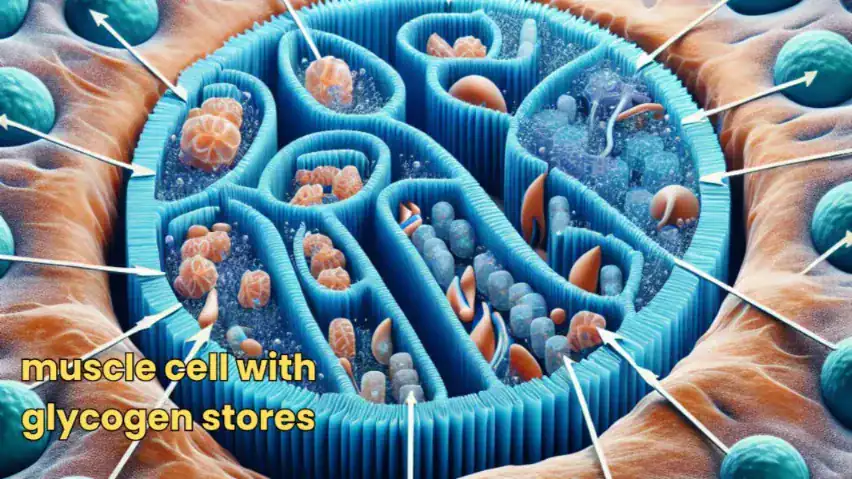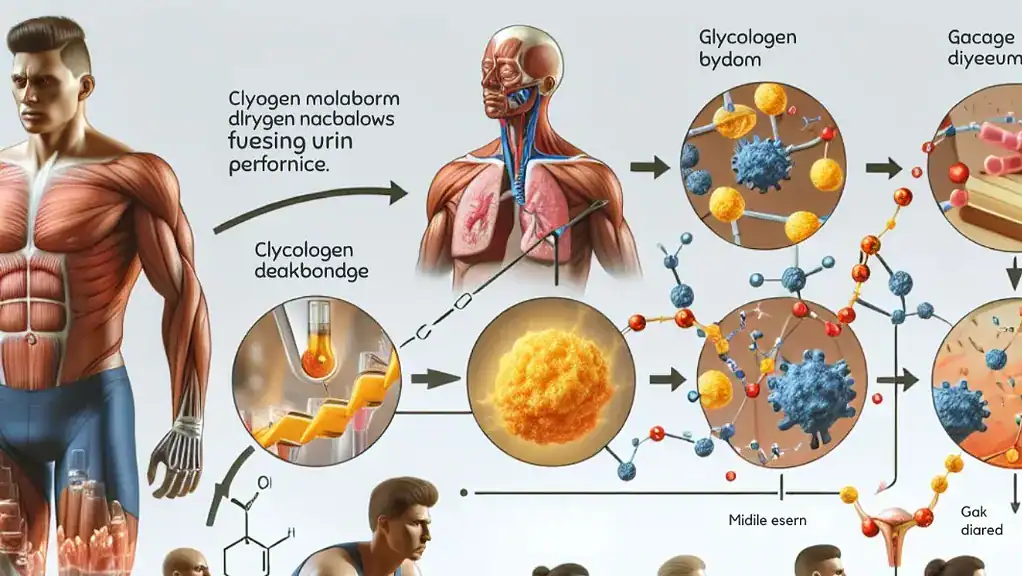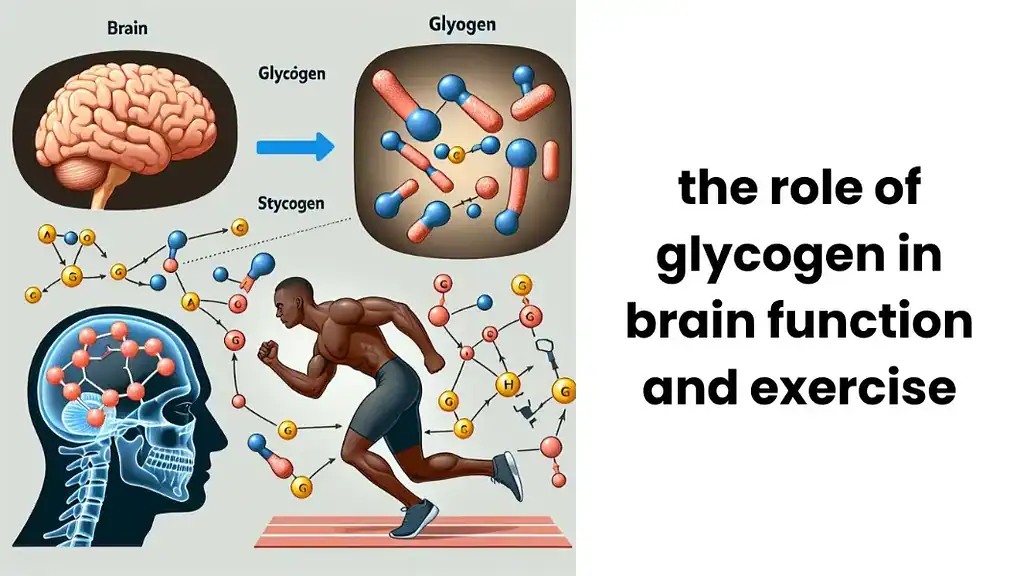Did you know that the energy stores of the average person could power a marathon runner for just 2 hours? This reality hits hard for the athletes, depending on their energy. I’m thrilled to explore the realm of glycogen and share the secrets of top athletic performance with you.
When you hit the gym, your body loves to burn glycogen. It’s the energy stored from carbs and sugars, making it key for sports. But here’s the catch: you have a limited supply. Run out, and you hit the wall. So, eating carbs is a must to keep your storage full and your body going.
As your workout heats up, your body turns to glycogen faster than a book on fire. Why? Because fat alone can’t keep up with high-speed energy needs. Not having enough glycogen causes serious problems. It can harm your muscles, push you into overdrive, and lead to exhaustion. Knowing how to keep up your glycogen is crucial for being your best in sports.
Key Takeaways
- Glycogen powers your muscles during sports, and running out can cause tiredness and exhaustion.
- Eating enough carbohydrates is crucial to keeping your glycogen stores full and performing well.
- At high exercise levels, your body needs glycogen more, and it’s the main fuel for energy.
- If your glycogen is low, it can harm your muscles and lead to overtraining.
- Learning how to manage your glycogen well is key to peak athletic performance.
Introduction to Glycogen and Its Importance in Exercise
Carbohydrates are key for the body, especially when we exercise. Glycogen is how our body stores carbs. It’s very important for sports. Because it’s the main way our muscles get energy, it helps us last longer and go harder in activities.
The Role of Carbohydrates in Athletic Performance
Our body doesn’t store a lot of glycogen in our muscles and liver. If it runs out, we get tired quickly and might not do as well in long activities. That’s why topping up on carbs is crucial to keeping going. During hard exercises, our body uses a lot of glucose because fats can’t keep up.
Glycogen as the Primary Fuel Source for Muscular Activity
Glycogen is top choice for making the energy our body needs, called ATP, during a workout. If our glycogen is low, it’s bad news. This can cause our muscles to break down and lead to overworking them. Keeping an eye on how our body stores and uses glycogen is vital for doing well in sports.
The Biochemistry of Glycogen Metabolism

Glycogen metabolism is all about making and breaking down key sugar stores. It’s mainly about creating glycogen and then using it to have glucose when needed.
Glycogenesis: The Process of Glycogen Synthesis
The first step in making glycogen is changing glucose-6-phosphate to glucose-1-phosphate. Then, this is turned into UDP-glucose. This UDP-glucose helps grow the glycogen molecule, with glycogenin working as the starter. The structure and use of glycogen are controlled by the glycogen branching enzyme and glycogen debranching enzyme. They make sure glucose is stored and used well.
Glycogenolysis: The Breakdown of Glycogen for Energy
To get energy, our body breaks down glycogen. It turns glycogen into glucose-1-phosphate. Then, this becomes glucose-6-phosphate, which starts the process of making ATP, the energy of cells.
Regulation of Glycogen Metabolism by Hormones
Hormones like insulin, glucagon, and adrenaline control how glycogen is used. Insulin helps make glycogen and store it. Glucagon and adrenaline speed up its use. This way, the body can adjust to energy needs and keep a steady glucose level.
Glycogen Depletion and Fatigue During Exercise
When you exercise for a long time, your body uses up its stored energy from glycogen. This makes you tired. How fast you lose this energy depends on how hard and how long you exercise. If you run out of glycogen, your body might start using protein to make more energy, breaking down muscle in the process. This cycle can lead to muscle damage and overtraining issues, making it harder for your body to store glycogen again.
Factors Affecting Glycogen Utilization During Exercise
Glycogen use changes based on how hard and how long you exercise. If you exercise harder, you use up glycogen faster. If you do endurance sports, like long-distance running, you will also use up a lot of glycogen over time. Being fit helps, as it lets your body use its glycogen more efficiently.
The Role of Carbohydrate Loading in Glycogen Replenishment
Carbohydrate loading is a strategy to fight fatigue from running low on glycogen. Athletes eat lots of carbs before a big event to fill up their glycogen stores. This helps them last longer without getting tired, especially in endurance sports.
Glycogen Metabolism and Athletic Performance
Keeping enough glycogen is key for top performance during long activities. The body might use more fat and protein as glycogen runs out. This can make you tired sooner, hurt your muscles, and cause overtraining. Working to save glycogen while exercising can help you stay strong longer.
Importance of Adequate Glycogen Stores for Endurance Events
For long exercises like marathons, athletes need plenty of glycogen in their muscles. As this fuel runs low, the body looks to fats and proteins for energy. This change can greatly lower how well you perform. So, it’s vital for these athletes to keep enough glycogen. This way, they avoid the downsides of using up all their fuel.
Glycogen Sparing Strategies During Prolonged Exercise
To perform well for longer, athletes can use glycogen-saving tips. A big one is getting the right carbohydrate intake before, during, and after they work out. This mix helps get glucose to their muscles well, keeping fatigue away and glycogen stores up. Also, they can try methods that make using fat for energy better and using less protein during exercise. This also helps with glycogen sparing and improving how they perform.
Nutritional Strategies for Optimal Glycogen Management

Getting your glycogen stores right is key for doing well in sports. It’s vital to eat carbs at the right times. The best time to refill your glycogen is right after you work out. Take in both simple and complex carbs to boost glycogen levels well.
Carbohydrate Intake and Timing for Glycogen Loading
The timing and types of carbs you eat are very important for restoring glycogen. Just after you work out is when your body needs it most. Having carbs that raise your blood sugar quickly, like glucose, with slower carbs like oats, helps a lot.
The amount of carbs you need depends on your weight, how hard and long you exercise, and if you’re used to training. Usually, it’s good to eat 1.0–1.2 grams of carbs per kilogram of your weight every hour for the first few hours after working out.
The Role of Carbohydrate Mouth Rinsing in Exercise Performance
Some new studies show that rinsing your mouth with a carb solution can make you perform better. You don’t swallow the solution; you spit it out. It’s thought that having carbs in your mouth could tell your brain to push harder, helping you work out longer and better.
Even though we’re still figuring out how it works, rinsing your mouth with carbs might be a plus in short, tough exercises. It can be a good trick for athletes wanting to skip tummy problems that big carbohydrate servings during exercise can cause.
Holistic care in looking after your glycogen, including smart carb eating, timing, and even mouth rinsing, could be what’s needed to reach your sport goals. It helps keep your energy up for both training and competing.
Glycogen Metabolism Disorders and Their Impact on Exercise
The world of exercise and sport faces some tough issues. One big challenge is glycogen metabolism disorders. These are genetic problems that make it hard for someone to take part in sports and achieve their fitness goals.
Several diseases like McArdle, Pompe, Cori, Andersen, Hers, and Tarui disease, stop the body from using or making enough glycogen. This can cause problems, including not being able to exercise for long, muscle cramps, and other tough issues. These things can really limit how much someone can do sports and work out.
People with these diseases find it hard to keep up the glycogen they need for muscle work during sports. The lack of certain enzymes because of these issues stops the body from saving and using glycogen well. So, they face big hurdles in being at their best in sports and exercise.
To deal with glycogen metabolism problems, it’s key to really know how the body works. Also, understand what exactly goes wrong because of these genetic errors. By teaming up with doctors and using special diets and exercise plans, those with these issues can try to do more physical things.
The Role of Glycogen in Brain Function and Exercise

Glycogen is the storage for glucose, which is vital in muscles and the brain. It’s stored by astrocytes in the brain. This storage can be turned into energy, mainly lactate, to help the brain work harder during exercise.
Glycogen Storage and Utilization in the Central Nervous System
Astrocytes in the brain hold glycogen for quick energy use by nerve cells. When the brain is working hard, like when you’re exercising, this glycogen is broken down. It helps meet the brain’s high energy needs. Neurons nearby then use this energy, keeping you sharp and active.
The Relationship Between Brain Glycogen and Exercise Performance
Studying brain glycogen and its link to exercise performance is hot right now. It seems having enough brain glycogen is key to both thinking and moving well during tough exercise. The brain always needs steady energy. Using glycogen from astrocytes helps keep us going and hold off tiredness.
Conclusion
Understanding glycogen metabolism is key to better athletic performance. Glycogen is the main energy source for muscles. It’s very important for long and high-intensity exercises. When glycogen stores run low, issues like fatigue and muscle damage can happen. This shows how important it is to manage nutrition for glycogen.
Carbohydrate intake, its timing, and the types you eat matter a lot. They help keep glycogen levels good for your workouts. Also, glycogen affects brain function and how well you perform in exercise. Learning about glycogen metabolism helps athletes and coaches do better in both training and matches.
By knowing more about glycogen storage and use, we can plan better exercise nutrition. This leads to improved athletic performance and avoids glycogen depletion. Athletes and coaches need this information. It can change a game from bad to good, knowing this.
Source Links
- https://pubmed.ncbi.nlm.nih.gov/1816789/
- https://www.trainingpeaks.com/blog/the-importance-of-carbohydrates-and-glycogen-for-athletes/
- https://www.ncbi.nlm.nih.gov/pmc/articles/PMC6019055/
As a veteran fitness technology innovator and the founder of GearUpToFit.com, Alex Papaioannou stands at the intersection of health science and artificial intelligence. With over a decade of specialized experience in digital wellness solutions, he’s transforming how people approach their fitness journey through data-driven methodologies.
